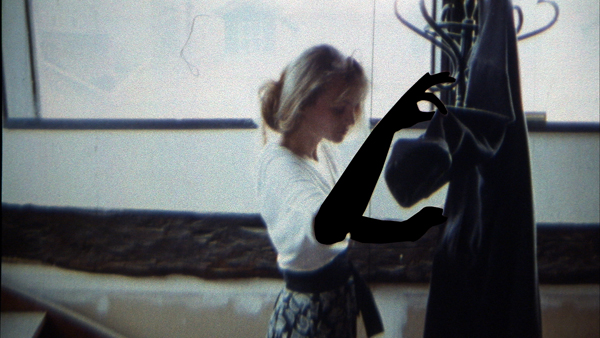Isabelle Prim

La rouge et la noire (2011) – Le film, l’objet du délit
Isabelle Prim est une de ces artistes chercheuses qui, à 27 ans, a déjà mené un parcours de combattante : école d’art de Grenoble en même temps que le conservatoire de théâtre, université de Berlin, post-diplôme aux beaux-arts de Lyon, Fresnoy et, bientôt, une thèse à l’université de L’UQAM à Montréal… Ce n’est donc pas un hasard si son dernier film, La rouge et la Noire, fouille et réécrit l’histoire du cinéma. Poursuivant le scénario inachevé de Luc Moullet autour du vol de « la pénélope », caméra créée par Aaton capable d’enregistrer aussi bien en 35 mm qu’en numérique, l’artiste produit un film en forme de kaléidoscope. Autour de l’intrigue de départ portée par deux voleuses qui dialoguent en voix off et dont l’identité ne sera révélée qu’à la fin, se noue le portrait du fondateur d’Aaton, Jean-Pierre Beauviala, créateur entre autres du timecode et des caméras légères de la Nouvelle Vague, en particulier de la « caméra de brousse » spécialement conçue pour Jean Rouch. Le film tisse sa toile à travers des régimes d’images multiples : les archives privées de Beauviala tournées en 16 mm, des images que l’artiste produit dans les espaces de travail d’Aaton, des incrustations numériques d’un petit monstre qui, à l’écran, se métamorphose. Ce dernier, avatar issu de l’icône publicitaire d’Aaton du « chat sur l’épaule », traverse et parasite le film, incarne la menace potentielle et en constitue le fil narrateur. Par un travail de désynchronisation du son et de l’image, Isabelle Prim creuse l’écart entre l’action et son commentaire et démultiplie les signifiants de l’image, au point d’instaurer le doute sur ce qui nous est donné à voir. Jusqu’au lapsus final, quand les voleuses se trompent de caméra et, à la place, s’emparent de celle utilisée par Beauviala lui-même pour produire ses archives. La boucle est bouclée.

Isabelle Prim La rouge et la noire, 2011. Film produit par / Produced by Le Fresnoy, avec le soutien de / with the support of Aaton. D’après un scénario inédit de / From an original scenario by Luc Moullet. Avec / with Jean-Pierre Beauviala, Thora Van Male, Luc Moullet, Julien Anselmino et / and Arielle Dombasle.
La rouge et la noire (The Red and the Black) (2011) – Film, Object of the Offence.
Isabelle Prim is one of those inquiring artists who, at 27, has already beaten a combative path: Grenoble art school at the same time as the theatrical conservatory, Berlin university, postgraduate degree in fine arts at Lyon, Fresnoy, etc, a thesis at the UQAM University in Montreal… So it is no coincidence if her latest film, La Rouge et la Noire, delves into and re-writes the history of the cinema. Carrying on Luc Moullet’s unfinished screenplay about the theft of “la pénélope”, a camera created by Aaton and capable of recording equally well in 35 mm and digitally, the artist produces a film in kaleidoscope form. The portrait of Aaton’s founder, Jean-Pierre Beauviala—creator, inter alia, of the ‘time-code’ and the light cameras used by the New Wave (in particular the “bush camera” specially designed for Jean Rouch)—is centered around the basic plot introduced by two women thieves who talk as voice-overs, and whose identities will only be revealed at the end. The film weaves its canvas through many different styles of imagery: Beauviala’s private archives shot in 16 mm, images that the artist produces in Aaton work areas, digital inlays of a little monster who metamorphoses on the screen. This latter, a variant hailing from the Aaton advertising icon of the “cat on the shoulder”, permeates and interferes with the film, embodying potential menace and representing the narrative thread. Through an operation involving the desynchronization of sound and image, Isabelle Prim creates a gap between the plot and her commentary, and increases the number of image-related signifiers, to the point of introducing doubt about what we are being shown. Right up to the final slip, when the thieving women get in a muddle over the camera, and make off with the one used by Beauviala himself to produce his archives. Full circle.
- Partage : ,
- Du même auteur : Jean-Charles Hue, Camille Henrot,
articles liés
Biennale Son
par Guillaume Lasserre
Lou Masduraud
par Vanessa Morisset
Bharti Kher
par Sarah Matia Pasqualetti